Effects of climate change on nature
This delta fact addresses the effects of climate change on terrestrial nature and the manner in which these effects are included in forecasting models in the Netherlands.
|
Thema |
Zoetwatervoorziening, Delta facts, English versions |
|
Tags |
|
|
Downloads |
- INTRODUCTION
- RELATED TOPICS AND DELTA FACTS
- CLIMATE CHANGE AND NATURE
- MODELS
- KNOWLEDGE GAPS
- CURRENTLY ACTIVE RESEARCH
Introduction
A substantial part of the Netherlands’ surface area consists of nature conservation. Nature areas are extremely varied and distances between forests, rivers, bogs and sea are short. National Government and Provincial authorities consider nature to be important with regard to the economy and the wellbeing of its citizens as well as for preserving plant and animal species.

The most important ecological functions and the quality of landscape, water and soil are secured in nature reserves. During the past decades, much has been invested in nature: new nature is being developed and many measures have been implemented to counteract the effects of fragmentation, water depletion, acidification and eutrophication on nature.
Nature reserves play a crucial role in the preservation of bio-diversity. To better guarantee this process, Natura 2000 areas were designated and the Ecological Structure (EHS) was formulated. Nature outside the Natura 2000 areas is currently being evaluated with regard to the management type areas, in the framework of the Subsidy Scheme Nature and Landscape (SNL).

Besides the intrinsic value, nature also has an economic value. The Dutch woods are harvested for timber, provide recreation, boost the value of houses situated in their vicinity and groundwater, extracted from large nature areas and processed into drinking water, has a superior quality owing to the filtering action of the soil and the absence of sources of pollution.
Changes caused by fluctuations in the CO2 content of the atmosphere can have a considerable effect on the quality of nature conservation areas and subsequently, their functions. A higher CO2 content could act as an extra ‘fertilizer’. Because of a changing climate, for example changes in temperature and precipitation, species currently present here could face hardship and possibly even become (locally) extinct while survival possibilities are opened for other (southern) species. In addition, indirect effects such as increased mineralization, for example, could have an influence on the presence or absence of species.
This delta fact addresses the effects of climate change on terrestrial nature and the manner in which these effects are included in forecasting models in the Netherlands. Information has partly been obtained from projects executed for the research programs of CcSp (Klimaat voor Ruimte) and Knowledge for Climate (Kennis voor Klimaat) as well as research conducted outside these programs, for instance the Ministry of Economic Affairs, Agriculture and Innovation (ELI) and in European projects.
Climate Changes Spatial Planning studied the impact of climate change and ways in which to deal with it, tailored to the lack of space, to support the decision-making about the country’s future spatial planning. This program was completed in December 2011.
Knowledge for Climate is mainly directed at the knowledge the Netherlands has and the organization of that knowledge into making the country climate proof. The intention is to first increase the Netherlands’ climate proofing and to then draw attention to this climate proofing and its accompanying knowledge base and experience. This should enhance the climate for business establishment and strengthen the export position of ’climate and delta technology’.
To cluster knowledge about climate change, a Climate portal was set up by the Platform Communication on Climate Change (PCCC). The PCCC is a co-operation of climate scientists of PBL, KNMI, NWO, WUR, UU, ECN, VU-A’dam, TNO and Deltares. The climate portal is the digital access of the Dutch knowledge institutes where up-to-date knowledge is gathered and integrated in relation to climate, climate change, consequences of climate change, adaptation and adjustment possibilities, mitigation measures and made available to policy makers, business sectors, interest groups, media and the public in general.
Related topics and Delta Facts
Climate scenarios, groundwater, adaptation and climate proofing
Related delta facts: effects of climate change on agriculture, soil as a buffer
Climate change and nature
The effects of increased CO2 content and climate change on nature can be grouped into three substantial effects: the direct effect of increased CO2 levels, changes in precipitation and temperature changes.
Increased CO2 levels in the atmosphere have a direct effect on plants. CO2 can be considered a fertilizer for the air, much like nitrogen is a fertilizer for the soil. In essence, plants could grow faster if it were increased, provided that other requirements (nutrients, light) are not limiting. It is possible that increased CO2 content will have a similar effect on plant growth as the nitrogen deposition, which may change mutual competition. This could subsequently result in changes in ecosystems that, in turn, have effects on ecosystem functions.
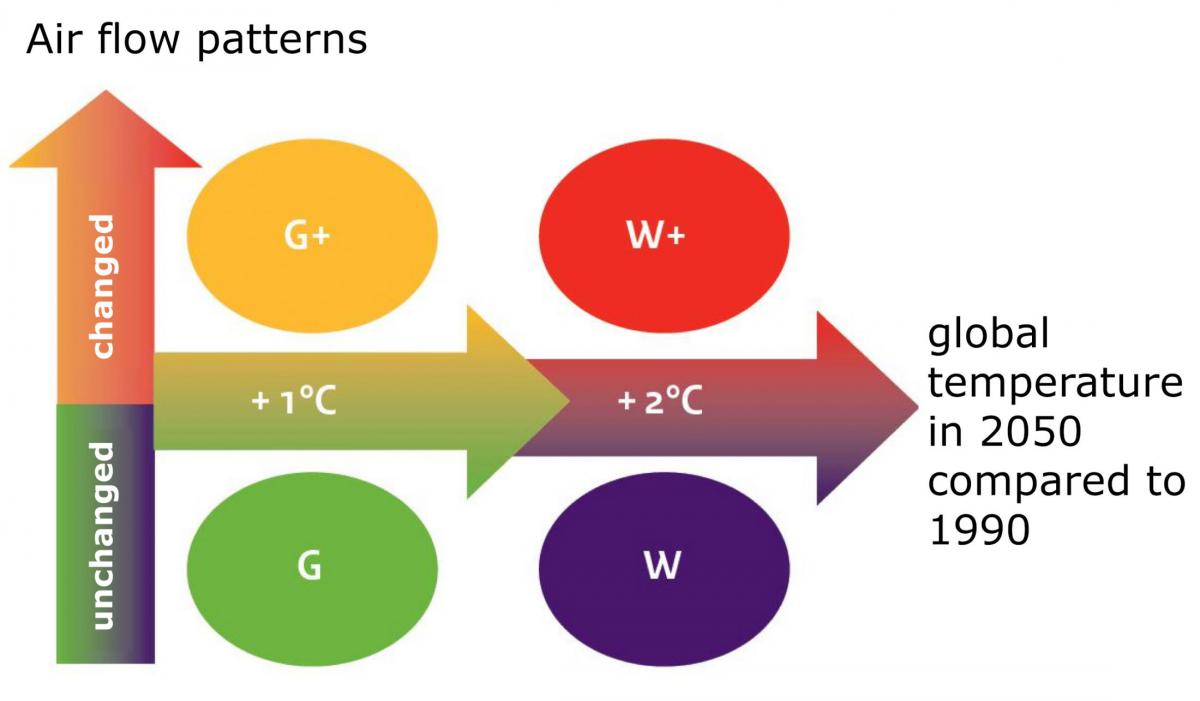
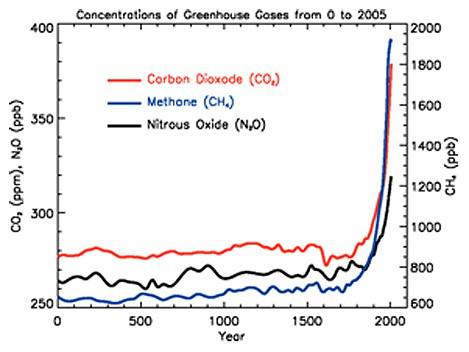
The climate also changes because of an increased CO2 levels. The expected and measured climate changes in the Netherlands will influence the temperature, precipitation, evaporation and weather extremes. In 2006, KNMI formulated four new climate scenarios for the Netherlands. These scenarios forecast an image of the possible changes in temperature, precipitation, wind speed and sea level for a climatological period of 30 years and are intended to be exploratory studies into the effects of climate change and possible adaptation to these changes. The table below provides and overview: on the left are the results for the target year 2050 and on the right, for the year 2100.

Each of the KNMI-06 scenarios consists of a number of corresponding trends:
- the warming persists, so mild winters and warm summers occur more frequently;
- on average, the winters are wetter and extreme amounts of rainfall increase;
- the intensity of extremely heavy rainfall in summer increases while the number of rainy summer days actually decreases;
- the calculated changes in wind climate are small if compared to the natural unpredictability;
- the sea level keeps rising.
Do bear in mind that the climate scenarios do not make statements about the weather on a certain date, only about average weather and the probabilities of extreme weather in the future. The climate in the chosen benchmark year 1990 contains data ranging from 1976 up to and including 2005. The scenarios for 2050 and 2100 are representative for the climate in the period round about that year (so between 2036 and 2065, and between 2085 and 2115).
In a supplement (KNMI 2009) the KNMI concludes that the calculated climate scenarios have not become out-dated by specific recent developments. According to current opinions, the four KNMI’06 scenarios combined represent the most probable changes likely to occur in the Netherlands, with the accompanying uncertainties. New insights do indicate that the rapid warming in the Netherlands and Western Europe are described best in the W/W+-scenario. The increased intensity of heavy precipitation is well rendered in the G/W-scenarios. Besides possible lengthy periods of drought as seen in the G+/W+-scenarios, periods of wetter weather will occur more frequently in coastal regions, as described in the G/W-scenarios. The KNMI will formulate new climate scenarios in 2013. The above-mentioned insights and possible new insights, including the spatial differentiation, will be included.
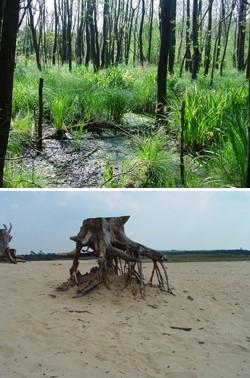
One of the factors that will have a substantial influence on nature and bio-diversity is the changing precipitation. More rain could help to solve the water depletion problem. It is important however, that when it does rain, something is done with the large quantities of precipitation. If the precipitation mainly occurs in winter and/or if the water is rapidly discharged, little positive effect will be experienced from increased precipitation. Wetter summers could prove a challenge for preserving drift-sand while dry summers could prove to be a challenge for preserving wet ecosystems such as raised bogs (van Bodegom et al., 2011, Bijlsma et al., 2011).
IPO has produced map images of such climate change patterns (see examples below). For the potential precipitation surplus (rainfall minus reference crop evaporation) W and W+ are respectively the wettest and the driest of the four scenarios.
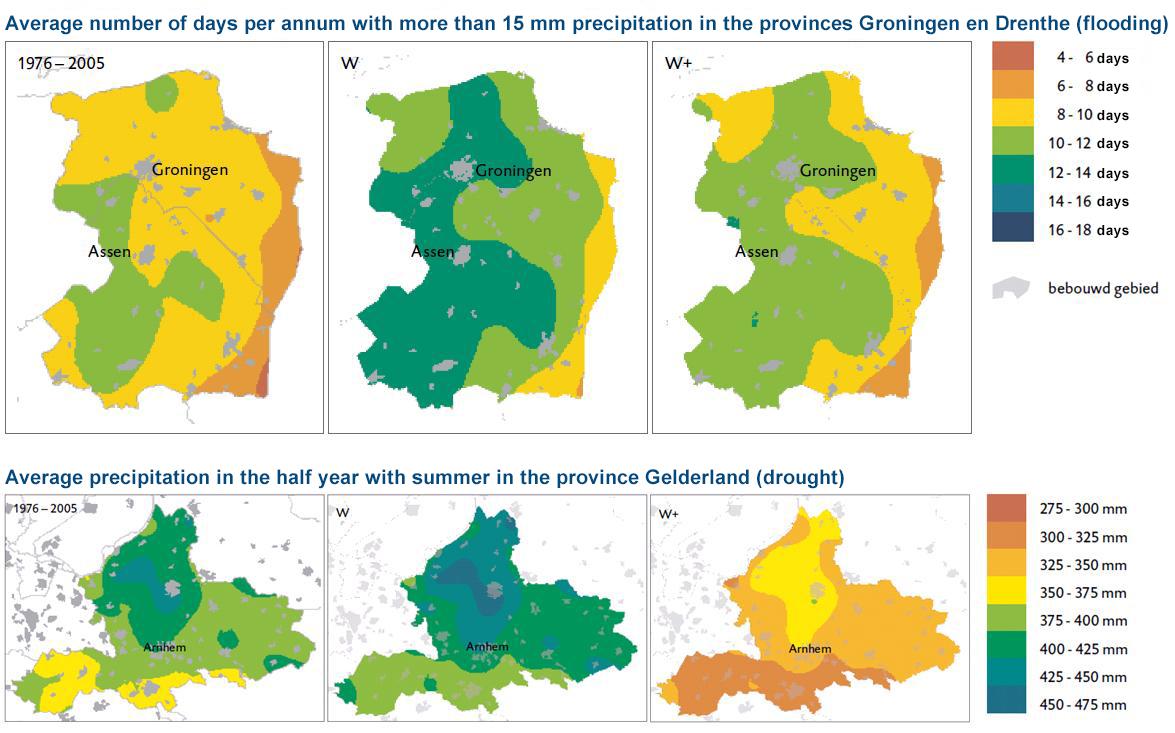
Annual meteorological data, preferably on a daily basis, are required to calculate the effects of climate change on the development of nature.
To calculate the effects of climate change on agricultural yield requires meteorological data on the whole year, preferably on a daily basis. KNMI has developed tools that make it possible to transform a time series based on daily rainfall, reference evaporation and temperature of a random measuring station to a future climate. This transformation not only takes into account the changes in the amount of precipitation, but also the changes in the intensity distribution of rainfall and shift changes in the precipitation distribution across the seasons.
Temperature change can also have a considerable effect on nature. It could become warm enough for large groups of species currently inhabiting areas south of the Netherlands to migrate north and live here. It could concern a large group of species; after all, during the past years the climate in southern Netherlands has been comparable to Lyon. On the other hand, there are certain species that will face more difficult conditions, as they regularly need frost for survival and on whom other species depend for their survival in turn. These species could disappear from the Netherlands. The same applies to newly arriving and departing species. This could result in changing competitive positions and could have impacts on the ecosystems and they way in which they function (Bodegom et al. 2011).
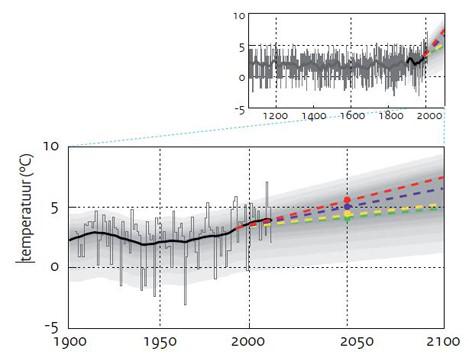
Using the same method, KNMI developed tools for the National Model and Data Centre [Nationaal Modellen en Data Centrum] (NMDC) for gathering data in relation to radiation, humidity, wind speed and temperature so that National Hydrological Tool (NHI)[Nationaal Hydrologisch Instrumentarium] is able to calculate the actual evaporation in accordance with the Penman- Monteith method. In this way, it is possible to make comparisons between crop growth, evaporation and the resulting groundwater supplement in a changing climate. Nowadays, the KNMI also has a better insight into regional differences of climate change in the Netherlands. Forecasts for changes in precipitation patterns for coastal areas are different to forecasts for the interior. In the tools to be developed for transforming the climate series, this spatial differentiation will be included.
Models
The Dutch traditionally use models to calculate the effects of future scenarios. The Environmental Assessment Agency (Natuur Planbureau) frequently uses their Nature planner together with the SMART2 models.
(Mol et al., 2007), SUMO2 (Wamelink et al., 2009a), MOVE4 (van Adrichem et al., 200?) and Biodiv of NTM (Wamelink et al., 2003).
For forest growth, there is FORSPACE (Kramer et al., 2001) or EFISCEN (also on European scale; Puissinen et al., 2009). Besides this, other options are for instance Century-PROBE (KWR, Witte et al., 2007; Bartholomeus et al., 2008) and NUCOM (Heijmans et al., 2008), whereby the latter model in particular is used for scientific process research. Hydrology frequently uses models that are now combined in NHI and sometimes reverts back to maps with groundwater information, whether or not influenced by scenarios.
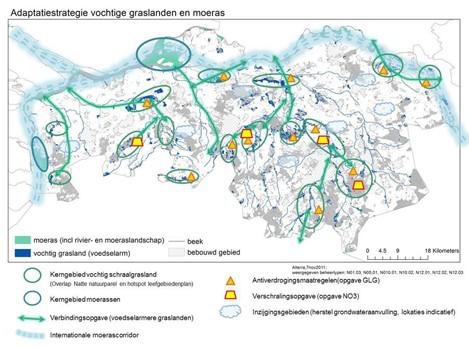
Even though there are a number of different models (chains) available, the calculated processes are largely the same even though there are important differences in emphasis. The hydrological information is often obtained from other models, such as the NHI or separate models within NHI or even affiliated models. For the modelling of natural vegetation, the potential evaporation, the groundwater levels or oxygen and drought related stress is used for modelling calculations. Nutrient cycles are subsequently calculated, sometimes limited to only nitrogen and sometimes including alkaline cations and phosphorus. Typical results regarding soil calculations are the pH value, the C/N balance, the availability and concentrations of nitrogen and ammonium. The availability of nutrients and moisture for the vegetation is passed on the vegetation model with which biomass is modelled, generally for a number of functional types of vegetation.
In the vegetation success models, based on the bio-mass distribution across the functional types – for instance trees, shrubs, stunted shrubs, grasses and herbs – the presence of types of vegetation is verified.
However, this type of vegetation can change during the course of a model run. The SUMO model therefore additionally models the management policy executed. This does not only have an influence on the vegetation structure but also on the quantity of biomass and the nutrients drained from the system. The most common forms of management are included in the model, such as mowing, turf and forestry management. In addition, the effects of grazing are modelled for fifteen different types of grazers – wild as well as domesticated grazers.
One of the means used for measuring bio-diversity is looking at the kinds or types of vegetation that could be present. The possible composition of plant varieties is then based on the data yielded by soil modelling related to the availability of nitrogen, the degree of acidity (pH value) and the availability of moisture, in PROBE and Move for instance.
Assessment is made according to the predicted number of target species and/or the number of undesired species. NTM is an alternative method based on species, in which all species were allocated a nature conservation value. This nature conservation value was subsequently linked to the soil parameters. In this way, the forecast for nature conservation is based on the soil parameters.
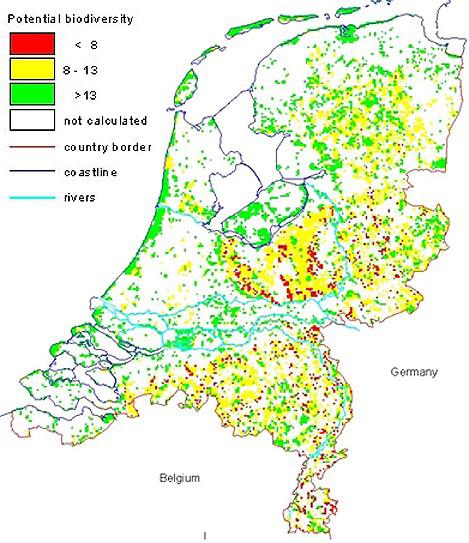
With regard to animals, the point of departure often is the sustainable presence of populations, using the Metaphor en LARCH models. Based on species characteristics, landscape features and connectivity as well as landscape coherence, assessments are made on whether a species can sustainably exist. This method is also frequently used to evaluate the connectivity of the landscape and make recommendations for connections between fragmented parts of the landscape.
Knowledge gaps
New species
Even though the models mentioned all have modifications to include climate change in the calculations, there are still many uncertainties. Probably one of the most important of these is the effect that climate change will have on the departure of certain species, but also on the arrival of other species. This will have an effect on the competitive position of all species. Not only do the new arrivals have to conquer a place for themselves but also the species that remain here have to do the same in the face of new competition. The dispersal capacity of species will play an important role. In the past attention was mainly focused on the dispersal of animals but the issues related to limited dispersion capacity and barriers also applies to plants. Calculations in this regard can be executed for animals with LARCH (2002) or Metaphor (Vos et al., 2001) and for plant species, with DIMO (Wamelink et al., in prep).
Soil and groundwater processes
On yet another scale, there are the direct and indirect influences of climate change on soil and groundwater processes. Various models have had different modifications; often these were based on different insights. The advantage is that the different models can be compared and partly independent effects can be calculated. However, the most important effects of climate change on soil processes are still relatively unknown. An additional complicating factor is that there are indications that the speed of mineralization could (temporarily) increase under certain conditions. During the year this is an increased net yield of nitrogen availability and therefore, it could result in a continued (internal) fertilization of nature.
Interaction with other themes
The effects of climate change are linked to several themes such as fragmentation, dehydration and fertilization. Two of these have been touched on above. Particularly the effect of climate change on the fragmentation of plant species, in combination with its dispersion capacity, is still rather unknown. Quite a reasonable amount of fundamental research has been executed but for the national effects per species, considerable information per species is needed. The possibilities related to allowing plants to disperse through a fragmented landscape (wind, animal etc) are relatively unknown factors. However, in relation to animals, essential information is also often lacking.
Whether climate change will have an effect on nitrogen availability is as yet unknown and it is quite possible that it is a regional effect that corresponds with the availability of moisture. What is clear however, is the fact that should mineralization increase and with that the availability of nitrogen, this would be added to the problem of nitrogen deposition. It could finally result in decreasing the critical deposition values. Important in this regard are the effects of climate change on precipitation and moisture availability. Mineralization could be affected by changes in this regard. The fact that precipitation and availability of water have an influence on dehydration does not come as a surprise. However, the amount of precipitation is part of the climate scenarios and the effects of that are subject to research estimates. Calculating future effects therefore contain uncertainty. An example of this is found in the differences between the W en W+ scenario, whereby the dehydration under the W scenario possibly decreases and in the W+ scenario it increases.
Many discussions (mainly international) either solely address climate change or solely address nitrogen deposition while it is most likely that there is an interaction between the two. This interaction is hardly taken into consideration. In fragmentation and dehydration, this is clearly less prominent.
Currently active research
Fundiv EU project
Within the European Fundiv project, research is executed into the effect of climate change, air pollution and management due to the bio-diversity of trees in European forests. Among other things, the water and nutrient cycle is being looked at.
VIDI project Monique Heijmans
Global warming is strongest in the very North and may have consequences for the stability of the permafrost soils and greenhouse gas emissions that will result. Tundra vegetation will also be affected by global warming: shrubs in particular are increasingly expanding. Field research, by Wageningen University (NCP) in the pristine tundra of Northeast Siberia showed that shrub vegetation protects the permafrost and, in doing so, provides a reduction in thaw.
During the five years of the Vidi research programme, field experiments are used to assess how the vegetation influences the thawing of permafrost and what the subsequent consequences are for the soil processes and for the composition of vegetation. The findings are processed in a tundra ecosystem model, NUCOM-tundra, which will be used to determine the long-term effects of climate change on composition of vegetation and permafrost thaw. By learning about the processes that are important on the tundra, new insights are possibly gained in the processes that also play a part in climate change in the Netherlands.
Care project KVK
In the Care project, part of Knowledge for Climate, research is executed into the effect of climate change on water balance, the composition of vegetation and ecological networks for animals and plants. The objective is to assess which adaptive strategies are required to climate proof the abovementioned functions. Research is taking place into spatial and habitat requirement of species, while attention is also paid to how managers are dealing with change and the proposed adaptation strategies. Care is innovative because it strives to optimize in water management, bio-diversity, the extraction of drinking water, recreation and agriculture.
NMDC innovation project Integraal Waterbeheer, Kritische Zone
In this NMDC-innovation project for the Nationale Modellen en Data Centrum, several knowledge institutes WUR, TNO, Deltares, PBL and the KNMI are cooperating in order to fine-tune mutual adjustment of models for water management and ensure suitability for simulating climate effects. In two pilot areas, Walcheren and the Baakse Beek, models for hydrology, nature and agriculture are linked together.
KNMI is generating a new climate series for forecasting climate effects. For the pilot in Baakse Beek, MetaSwap was built into the regional hydrological model AMIGO and linked to SMART2-SUMO2. In the pilots the current situation is dynamically calculated in time (1980 -2010) and the future situation (2035–2065) according to the climate scenarios G and W+. The effects for the soil and for nature will subsequently be calculated by models SMART-SUMO and NTM to be able to make statements about climate change and soil processes, vegetation growth and composition and bio-diveristy.
At the same time as the NMDC project Baakse Beek, a project is running at the Provincial authority Gelderland in which the effects of climate change in the area will be researched by KWR with the Century PROBE models. For the area process and efficient knowledge development, both model studies will be synchronized.

 English resume
English resume